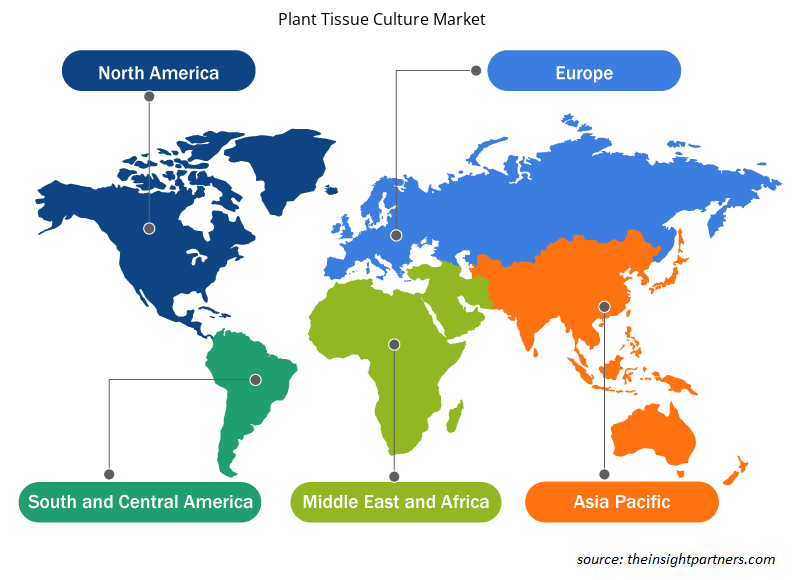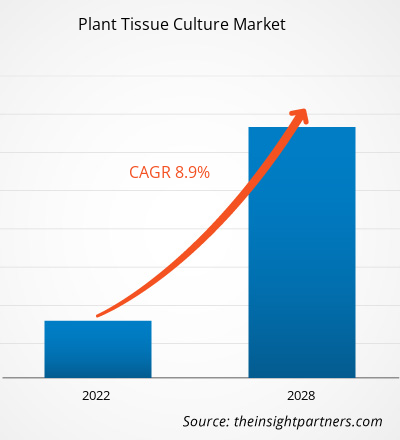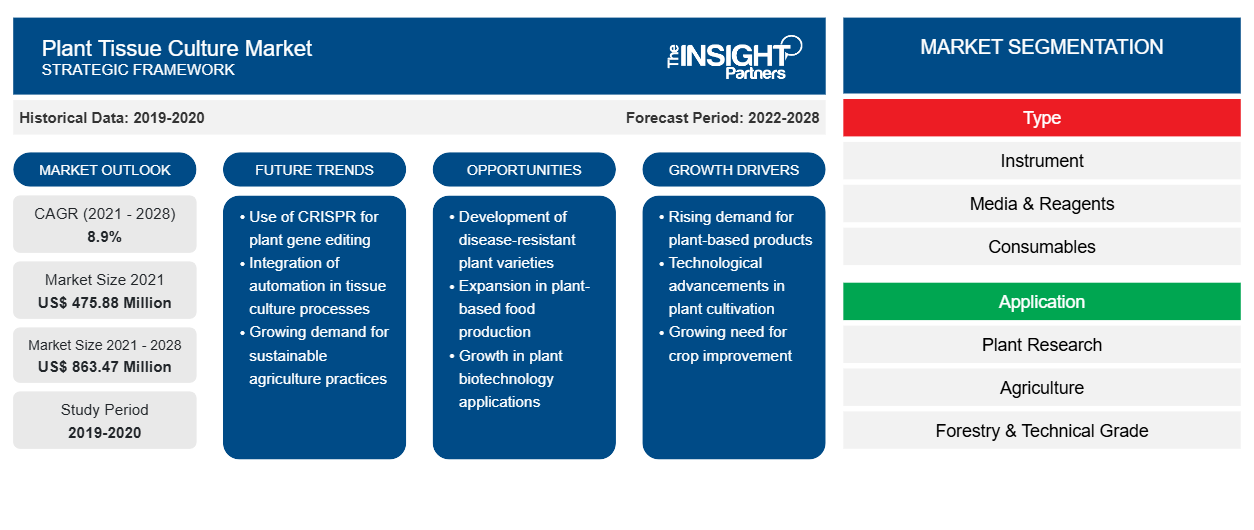[Rapporto di ricerca] Il mercato delle colture di tessuti vegetali è stato valutato a 475,88 milioni di dollari nel 2021; si prevede che crescerà a un CAGR dell'8,9% dal 2022 al 2028.CAGR of 8.9% from 2022 to 2028.
La coltura di tessuti vegetali è un insieme di tecniche utilizzate per far crescere cellule, tessuti o organi vegetali in condizioni in vitro su un terreno di coltura di composizione nota. I cloni delle piante possono essere prodotti tramite micropropagazione. La coltura di tessuti consente la produzione di materiali di piantagione di alta qualità e privi di malattie. Facilita inoltre la crescita rapida e uniforme delle piante. La crescente domanda di piante transgeniche e la proliferazione della floricoltura sono i fattori chiave che guidano la crescita del mercato. Tuttavia, l'elevato costo delle procedure di coltura di tessuti ostacola il progresso del mercato.vitro conditions on a culture medium of known composition. Clones of plants can be produced through micropropagation. Tissue culture enables the production of disease-free, high-quality planting materials. It also facilitates the speedy and uniform growth of plants. The increasing demand for transgenic plants and the proliferation of floriculture are the key factors driving the market growth. However, the high cost of tissue culture procedures hampers the market progress.
Il mercato delle colture di tessuti vegetali viene analizzato in base a tecnologia, applicazione, materiale e geografia. Il rapporto offre approfondimenti e analisi approfondite del mercato delle colture di tessuti vegetali, sottolineando vari parametri quali tendenze di mercato, progressi tecnologici e dinamiche di mercato, nonché l'analisi del panorama competitivo dei principali attori del mercato.geography.The report offers insights and in-depth analysis of the plant tissue culture market, emphasizing on various parameters such as market trends, technological advancements, and market dynamics, and the competitive landscape analysis of leading market players.
Personalizza questo report in base alle tue esigenze
Riceverai la personalizzazione gratuita di qualsiasi report, comprese parti di questo report, o analisi a livello nazionale, pacchetto dati Excel, oltre a usufruire di grandi offerte e sconti per start-up e università
- Scopri le principali tendenze di mercato in questo rapporto.Questo campione GRATUITO includerà analisi di dati che spaziano dalle tendenze di mercato alle stime e alle previsioni.
Approfondimenti di mercato
La crescente domanda di piante transgeniche rafforza la crescita del mercato delle colture di tessuti vegetali
Le piante transgeniche sono quelle piante il cui DNA è modificato usando tecniche di ingegneria genetica per introdurre una nuova caratteristica nella pianta che non si verifica naturalmente. Queste piante transgeniche sono generate usando tecniche di ingegneria genetica in laboratorio alterando il corredo genetico, solitamente aggiungendo uno o più geni al genoma di una pianta. Le piante transgeniche sono sviluppate principalmente per fornire i nutrienti necessari e far fronte alla domanda di cibo in tutto il mondo.
Milioni di persone soffrono di malnutrizione, che è più diffusa nei paesi in via di sviluppo e sottosviluppati. Secondo l'Organizzazione Mondiale della Sanità (OMS), nel 2019, circa 462 milioni di persone erano sottopeso. Secondo l'UNICEF, quasi la metà di tutti i decessi di bambini sotto i cinque anni sono attribuiti alla denutrizione. Inoltre, nel 2020, circa 45,4 milioni di bambini sotto i cinque anni erano deperiti e circa 13,6 milioni di questi erano gravemente deperiti. Secondo Global Change Data Lab, nel 2019, l'8,9% della popolazione mondiale era denutrita. Le persone denutrite sono quelle che hanno un apporto calorico inferiore al fabbisogno energetico minimo. I ricercatori si stanno concentrando sullo sviluppo di piante transgeniche che forniscano le calorie necessarie per soddisfare questi fabbisogni calorici. La domanda di piante transgeniche sta alimentando la crescita del mercato delle colture di tessuti vegetali.undernutrition. Moreover, in 2020, about 45.4 million children under the age of five were wasted, and about 13.6 million out of these were severely wasted. According to Global Change Data Lab, in 2019, 8.9% of the world’s population was undernourished. Undernourished people are those who have calorie intake below minimum energy requirements. Researchers are focusing on developing transgenic plants that provide the required calories to meet these calorie requirements. The demand for transgenic plants is fueling the growth of the plant tissue culture market.
Informazioni basate sul tipo
In base al tipo, il mercato della coltura di tessuti vegetali è suddiviso in strumenti, terreni e reagenti e materiali di consumo. Il segmento degli strumenti ha detenuto la quota di mercato maggiore nel 2021. Tuttavia, si prevede che il segmento dei materiali di consumo registrerà il CAGR più elevato durante il periodo di previsione. Gli strumenti utilizzati nella coltura di tessuti vegetali includono frigoriferi, impianti di distillazione, sistemi di flusso d'aria laminare, bilance di pesatura, incubatori, centrifughe, sterilizzatori, ecc.CAGR during the forecast period. Instruments used in plant tissue culture include refrigerators, distillation plants, laminar air flow systems, weighing balance, incubators, centrifuges, sterilizers, etc.
Approfondimenti basati sulle applicazioni
In base all'applicazione, il mercato della coltura di tessuti vegetali è segmentato in ricerca sulle piante, agricoltura, silvicoltura e grado tecnico e altri. Il segmento agricolo ha rappresentato la quota maggiore del mercato nel 2021. Tuttavia, si prevede che il segmento della ricerca sulle piante registrerà il CAGR più elevato nel periodo 2022-2028.CAGR during 2022–2028.
Informazioni basate sull'utente finale
In base all'utente finale, il mercato della coltura dei tessuti vegetali è segmentato in serra, campo e laboratorio. Il segmento campo ha detenuto la quota maggiore del mercato nel 2021. Inoltre, si prevede che il mercato per questo segmento crescerà a un CAGR del 9,2% nel periodo 2022-2028.
In molti paesi, il COVID-19 ha limitato la mobilità delle persone attraverso i confini e i lockdown hanno contribuito alla carenza di manodopera per i settori agricoli, in particolare quelli caratterizzati da periodi di picco della domanda stagionale di manodopera o di produzione ad alta intensità di manodopera. Ad esempio, i divieti di viaggio all'interno dell'Unione Europea, così come la chiusura dell'area Schengen, hanno ridotto significativamente la forza lavoro disponibile per il settore ortofrutticolo in molti paesi europei. La carenza di manodopera ha portato a perdite di produzione e carenze nel mercato. L'emergenza COVID-19 ha compromesso la logistica, la distribuzione e le catene di fornitura dei prodotti orticoli. Ciò ha creato insicurezza alimentare, a causa di interruzioni nella catena di fornitura dei prodotti agricoli e, di conseguenza, gran parte della popolazione ha avuto difficoltà ad accedere a cibo fresco a prezzi ragionevoli. Tali fattori sopra menzionati hanno avuto un grave impatto sull'intero settore della coltura di tessuti vegetali.
Approfondimenti regionali sul mercato delle colture di tessuti vegetali
Le tendenze regionali e i fattori che influenzano il mercato delle colture di tessuti vegetali durante il periodo di previsione sono stati ampiamente spiegati dagli analisti di Insight Partners. Questa sezione discute anche i segmenti e la geografia del mercato delle colture di tessuti vegetali in Nord America, Europa, Asia Pacifico, Medio Oriente e Africa e America meridionale e centrale.

- Ottieni i dati specifici regionali per il mercato delle colture di tessuti vegetali
Ambito del rapporto di mercato sulla coltura dei tessuti vegetali
| Attributo del report | Dettagli |
|---|---|
| Dimensioni del mercato nel 2021 | 475,88 milioni di dollari USA |
| Dimensioni del mercato entro il 2028 | 863,47 milioni di dollari USA |
| CAGR globale (2021 - 2028) | 8,9% |
| Dati storici | 2019-2020 |
| Periodo di previsione | 2022-2028 |
| Segmenti coperti | Per tipo
|
| Regioni e Paesi coperti | America del Nord
|
| Leader di mercato e profili aziendali chiave |
|
Densità degli attori del mercato della coltura dei tessuti vegetali: comprendere il suo impatto sulle dinamiche aziendali
Il mercato Plant Tissue Culture Market sta crescendo rapidamente, spinto dalla crescente domanda degli utenti finali dovuta a fattori quali l'evoluzione delle preferenze dei consumatori, i progressi tecnologici e una maggiore consapevolezza dei benefici del prodotto. Con l'aumento della domanda, le aziende stanno ampliando le loro offerte, innovando per soddisfare le esigenze dei consumatori e capitalizzando sulle tendenze emergenti, il che alimenta ulteriormente la crescita del mercato.
La densità degli operatori di mercato si riferisce alla distribuzione di aziende o società che operano in un particolare mercato o settore. Indica quanti concorrenti (operatori di mercato) sono presenti in un dato spazio di mercato in relazione alle sue dimensioni o al valore di mercato totale.
Le principali aziende che operano nel mercato delle colture di tessuti vegetali sono:
- Segra International Corp
- Vivai JRT Inc.
- Thomas Scientific LLC
- Sigma-Aldrich Co LLC
- Laboratori HiMedia Pvt Ltd
Disclaimer : le aziende elencate sopra non sono classificate secondo un ordine particolare.

- Ottieni una panoramica dei principali attori del mercato delle colture di tessuti vegetali
Nel 2022, il Nord America deteneva la quota maggiore del mercato delle colture di tessuti vegetali. La crescita del mercato in questa regione è attribuita a un aumento delle attività di ricerca e sviluppo nel campo delle colture di tessuti. Inoltre, si prevede che l'Asia Pacifica registrerà il CAGR più rapido durante il periodo di previsione. Cina, Giappone e India sono i principali contributori al mercato delle colture di tessuti vegetali in questa regione. La crescita del mercato nell'APAC è attribuita all'aumento degli investimenti governativi nella promozione della ricerca basata sulle colture di tessuti, all'aumento delle scale di adozione di tecnologie avanzate e ai miglioramenti nelle infrastrutture a supporto dei laboratori di colture di tessuti.
In base alla geografia, il mercato delle colture di tessuti vegetali è segmentato in Nord America (Stati Uniti, Canada e Messico), Europa (Regno Unito, Germania, Francia, Italia, Spagna e resto d'Europa), Asia Pacifico (Cina, Giappone, India, Corea del Sud, Australia, resto dell'Asia Pacifico), Medio Oriente e Africa (Emirati Arabi Uniti, Arabia Saudita, Africa e resto del Medio Oriente e dell'Africa) e Sud e Centro America (Brasile, Argentina e resto del Sud e Centro America).
Profili aziendali
- Segra International Corp
- Vivai JRT Inc.
- Thomas Scientific LLC
- Sigma-Aldrich Co LLC
- Laboratori HiMedia Pvt Ltd
- Laboratori Caisson Inc.
- Laboratori Alpha Ltd
- Becton Dickinson e soci
- Laboratorio di coltura tissutale AL-Rajhi
- Al Wathba Marionette LLC
- Analisi storica (2 anni), anno base, previsione (7 anni) con CAGR
- Analisi PEST e SWOT
- Valore/volume delle dimensioni del mercato - Globale, Regionale, Nazionale
- Industria e panorama competitivo
- Set di dati Excel
Report recenti
Testimonianze
Motivo dell'acquisto
- Processo decisionale informato
- Comprensione delle dinamiche di mercato
- Analisi competitiva
- Analisi dei clienti
- Previsioni di mercato
- Mitigazione del rischio
- Pianificazione strategica
- Giustificazione degli investimenti
- Identificazione dei mercati emergenti
- Miglioramento delle strategie di marketing
- Aumento dell'efficienza operativa
- Allineamento alle tendenze normative























 Ottieni un campione gratuito per - Mercato delle colture di tessuti vegetali
Ottieni un campione gratuito per - Mercato delle colture di tessuti vegetali